2012 Hyundai Sonata parking brake
[x] Cancel search: parking brakePage 12 of 363
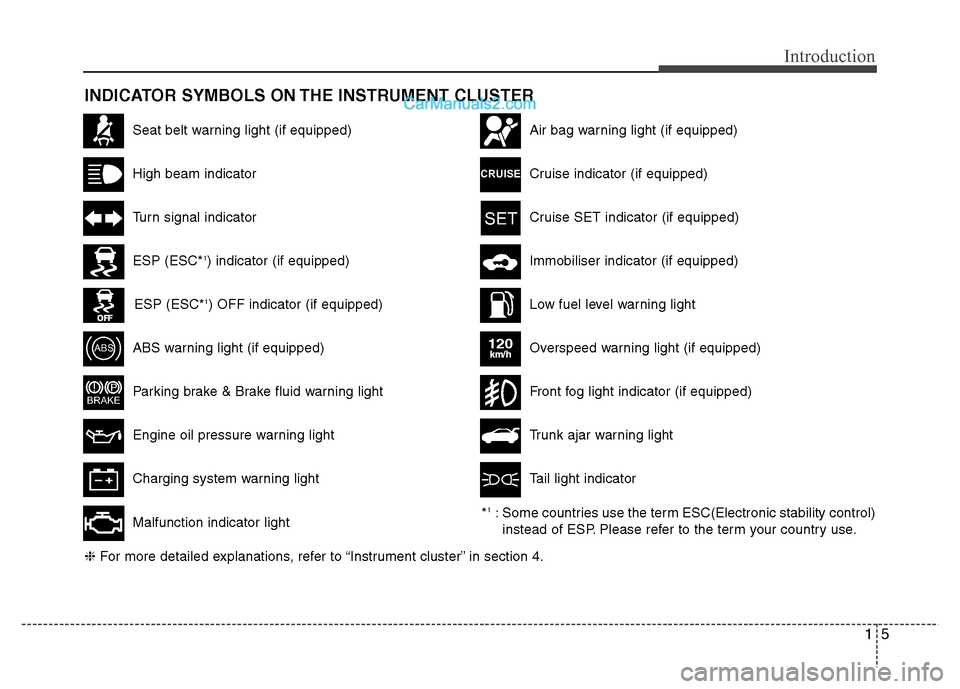
15
Introduction
INDICATOR SYMBOLS ON THE INSTRUMENT CLUSTER
Seat belt warning light (if equipped)
High beam indicator
Turn signal indicator
ABS warning light (if equipped)
Parking brake & Brake fluid warning light
Engine oil pressure warning light
ESP (ESC*1
) indicator (if equipped)
ESP (ESC* 1
) OFF indicator (if equipped)
Malfunction indicator light
Air bag warning light (if equipped)
Cruise indicator (if equipped)
Cruise SET indicator (if equipped)
Immobiliser indicator (if equipped)
Low fuel level warning light
❈ For more detailed explanations, refer to “Instrument cluster” in section 4.
Charging system warning light Overspeed warning light (if equipped)
120km/h
Tail light indicator
Trunk ajar warning light
Front fog light indicator (if equipped)
* 1
: Some countries use the term ESC(Electronic stability control)
instead of ESP. Please refer to the term your country use.
Page 14 of 363
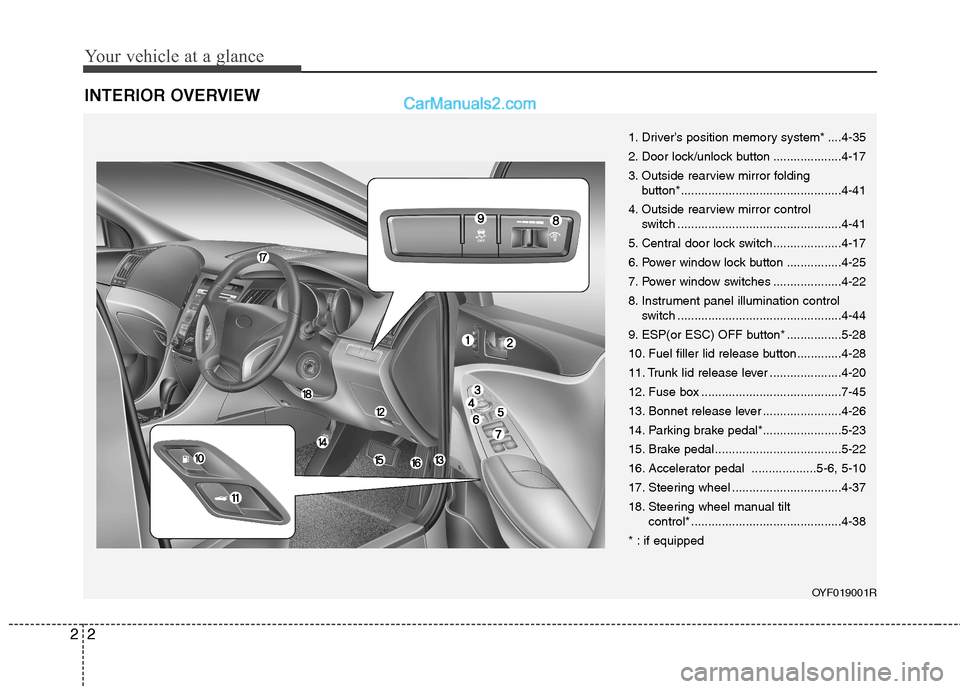
Your vehicle at a glance
2
2
INTERIOR OVERVIEW
1. Driver’s position memory system* ....4-35
2. Door lock/unlock button ....................4-17
3. Outside rearview mirror folding
button*...............................................4-41
4. Outside rearview mirror control switch ................................................4-41
5. Central door lock switch....................4-17
6. Power window lock button ................4-25
7. Power window switches ....................4-22
8. Instrument panel illumination control switch ................................................4-44
9. ESP(or ESC) OFF button* ................5-28
10. Fuel filler lid release button.............4-28
11. Trunk lid release lever .....................4-20
12. Fuse box .........................................7-45
13. Bonnet release lever .......................4-26
14. Parking brake pedal*.......................5-23
15. Brake pedal .....................................5-22
16. Accelerator pedal ...................5-6, 5-10
17. Steering wheel ................................4-37
18. Steering wheel manual tilt control* ............................................4-38
* : if equipped
OYF019001R
Page 32 of 363
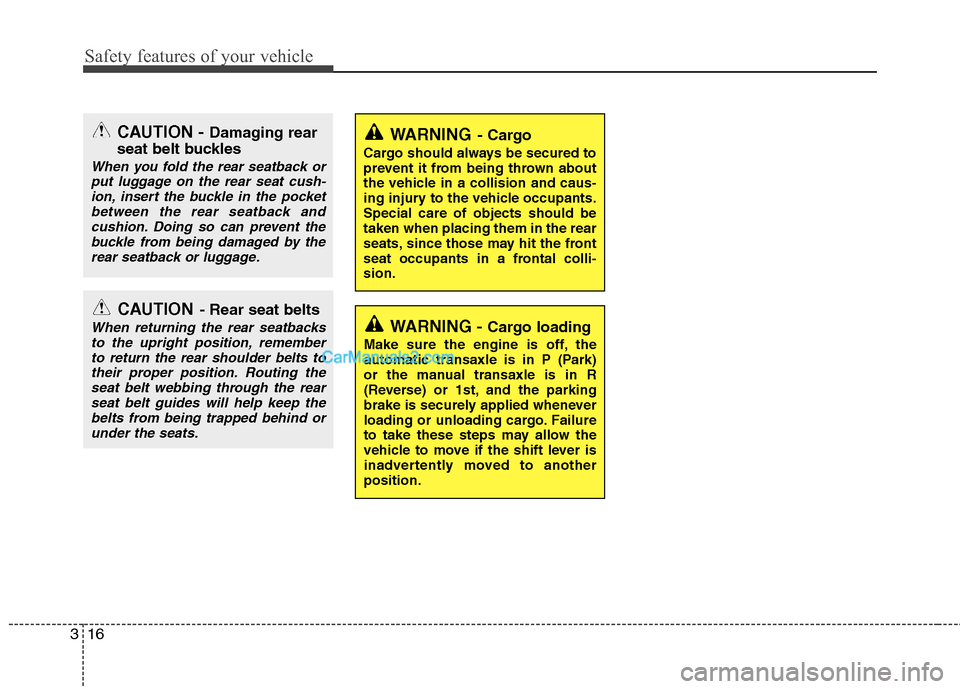
Safety features of your vehicle
16
3
WARNING - Cargo
Cargo should always be secured to
prevent it from being thrown about
the vehicle in a collision and caus-
ing injury to the vehicle occupants.Special care of objects should betaken when placing them in the rear
seats, since those may hit the front
seat occupants in a frontal colli-sion.
CAUTION - Rear seat belts
When returning the rear seatbacks
to the upright position, rememberto return the rear shoulder belts totheir proper position. Routing the
seat belt webbing through the rearseat belt guides will help keep thebelts from being trapped behind orunder the seats.
CAUTION - Damaging rear
seat belt buckles
When you fold the rear seatback or put luggage on the rear seat cush-
ion, insert the buckle in the pocketbetween the rear seatback andcushion. Doing so can prevent the buckle from being damaged by the
rear seatback or luggage.
WARNING - Cargo loading
Make sure the engine is off, the
automatic transaxle is in P (Park)
or the manual transaxle is in R
(Reverse) or 1st, and the parking
brake is securely applied whenever
loading or unloading cargo. Failure
to take these steps may allow the
vehicle to move if the shift lever is
inadvertently moved to anotherposition.
Page 88 of 363
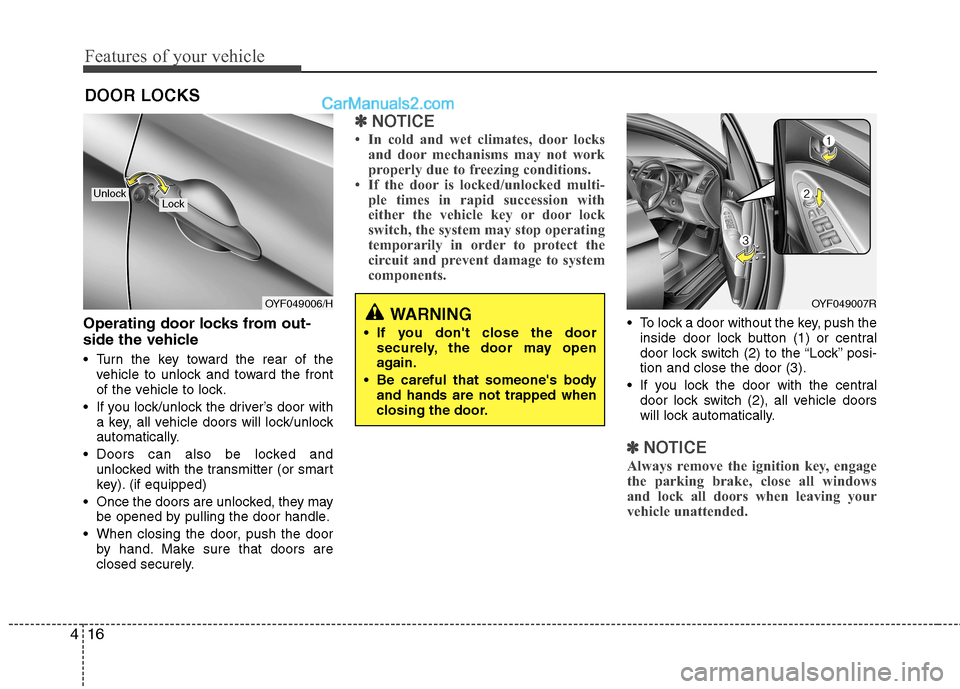
Features of your vehicle
16
4
Operating door locks from out-
side the vehicle
Turn the key toward the rear of the
vehicle to unlock and toward the front
of the vehicle to lock.
If you lock/unlock the driver’s door with a key, all vehicle doors will lock/unlock
automatically.
Doors can also be locked and unlocked with the transmitter (or smart
key). (if equipped)
Once the doors are unlocked, they may be opened by pulling the door handle.
When closing the door, push the door by hand. Make sure that doors are
closed securely.
✽✽ NOTICE
In cold and wet climates, door locks and door mechanisms may not work
properly due to freezing conditions.
If the door is locked/unlocked multi-
ple times in rapid succession with
either the vehicle key or door lock
switch, the system may stop operating
temporarily in order to protect the
circuit and prevent damage to system
components.
To lock a door without the key, push theinside door lock button (1) or central
door lock switch (2 ) to the “Lock” posi-
tion and close the door (3).
If you lock the door with the central door lock switch (2), all vehicle doors
will lock automatically.
✽✽ NOTICE
Always remove the ignition key, engage
the parking brake, close all windows
and lock all doors when leaving your
vehicle unattended.
DOOR LOCKS
OYF049006/H
LockUnlock
OYF049007RWARNING
If you don't close the door securely, the door may open
again.
Be careful that someone's body and hands are not trapped when
closing the door.
Page 90 of 363
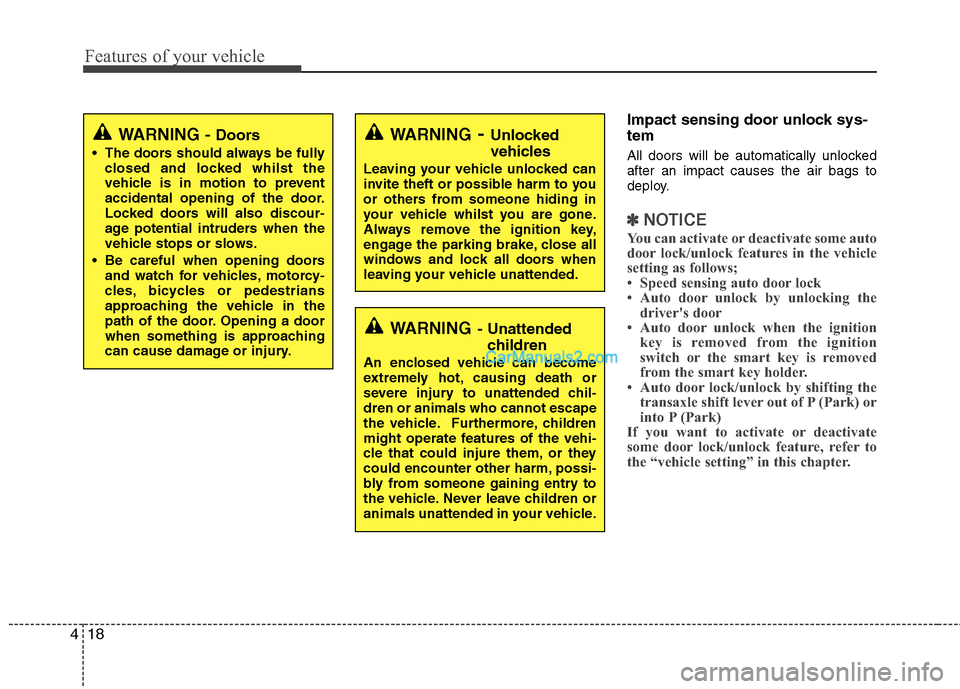
Features of your vehicle
18
4
Impact sensing door unlock sys- tem
All doors will be automatically unlocked after an impact causes the air bags to
deploy.
✽✽
NOTICE
You can activate or deactivate some auto
door lock/unlock features in the vehicle
setting as follows;
Speed sensing auto door lock
Auto door unlock by unlocking the driver's door
Auto door unlock when the ignition
key is removed from the ignition
switch or the smart key is removed
from the smart key holder.
Auto door lock/unlock by shifting the transaxle shift lever out of P (Park) or
into P (Park)
If you want to activate or deactivate
some door lock/unlock feature, refer to
the “vehicle setting” in this chapter.
WARNING - Unlocked
vehicles
Leaving your vehicle unlocked can
invite theft or possible harm to you
or others from someone hiding in
your vehicle whilst you are gone.
Always remove the ignition key,
engage the parking brake, close all
windows and lock all doors when
leaving your vehicle unattended.
WARNING - Unattended
children
An enclosed vehicle can become
extremely hot, causing death or
severe injury to unattended chil-dren or animals who cannot escape
the vehicle. Furthermore, children
might operate features of the vehi-
cle that could injure them, or they
could encounter other harm, possi-
bly from someone gaining entry to
the vehicle. Never leave children or
animals unattended in your vehicle.
WARNING - Doors
The doors should always be fully closed and locked whilst the
vehicle is in motion to prevent
accidental opening of the door.
Locked doors will also discour-
age potential intruders when the
vehicle stops or slows.
Be careful when opening doors and watch for vehicles, motorcy-
cles, bicycles or pedestrians
approaching the vehicle in the
path of the door. Opening a door
when something is approaching
can cause damage or injury.
Page 98 of 363
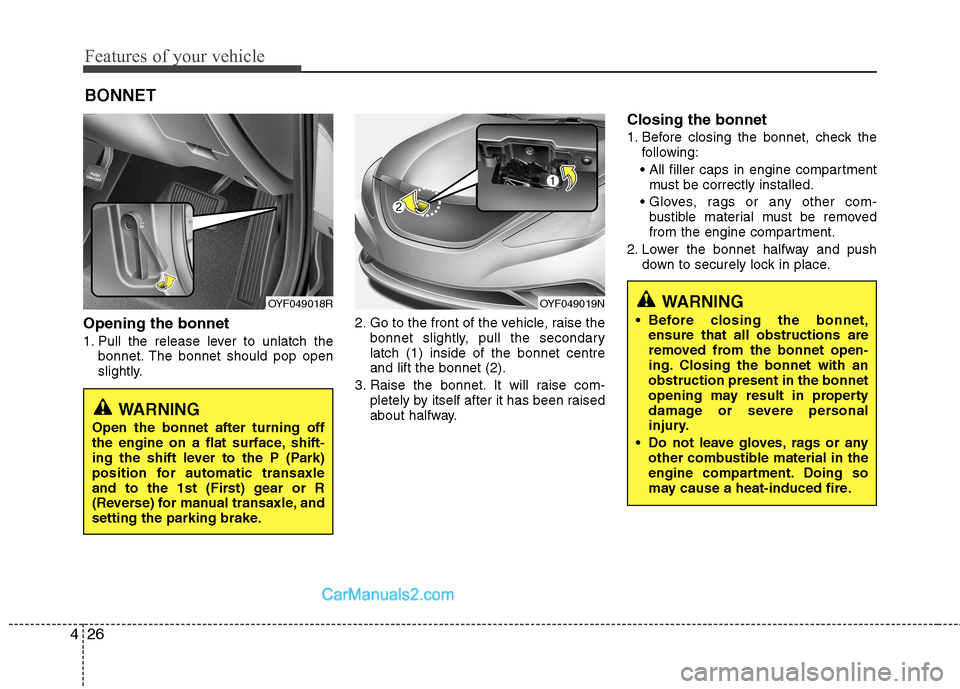
Features of your vehicle
26
4
Opening the bonnet
1. Pull the release lever to unlatch the
bonnet. The bonnet should pop open
slightly. 2. Go to the front of the vehicle, raise the
bonnet slightly, pull the secondarylatch (1) inside of the bonnet centreand lift the bonnet (2).
3. Raise the bonnet. It will raise com- pletely by itself after it has been raised
about halfway. Closing the bonnet
1. Before closing the bonnet, check the
following:
must be correctly installed.
bustible material must be removed
from the engine compartment.
2. Lower the bonnet halfway and push down to securely lock in place.
BONNET
OYF049018ROYF049019NWARNING
Before closing the bonnet, ensure that all obstructions are
removed from the bonnet open-
ing. Closing the bonnet with anobstruction present in the bonnet
opening may result in property
damage or severe personal
injury.
Do not leave gloves, rags or any other combustible material in the
engine compartment. Doing so
may cause a heat-induced fire.
WARNING
Open the bonnet after turning off
the engine on a flat surface, shift-
ing the shift lever to the P (Park)
position for automatic transaxle
and to the 1st (First) gear or R
(Reverse) for manual transaxle, and
setting the parking brake.
Page 124 of 363
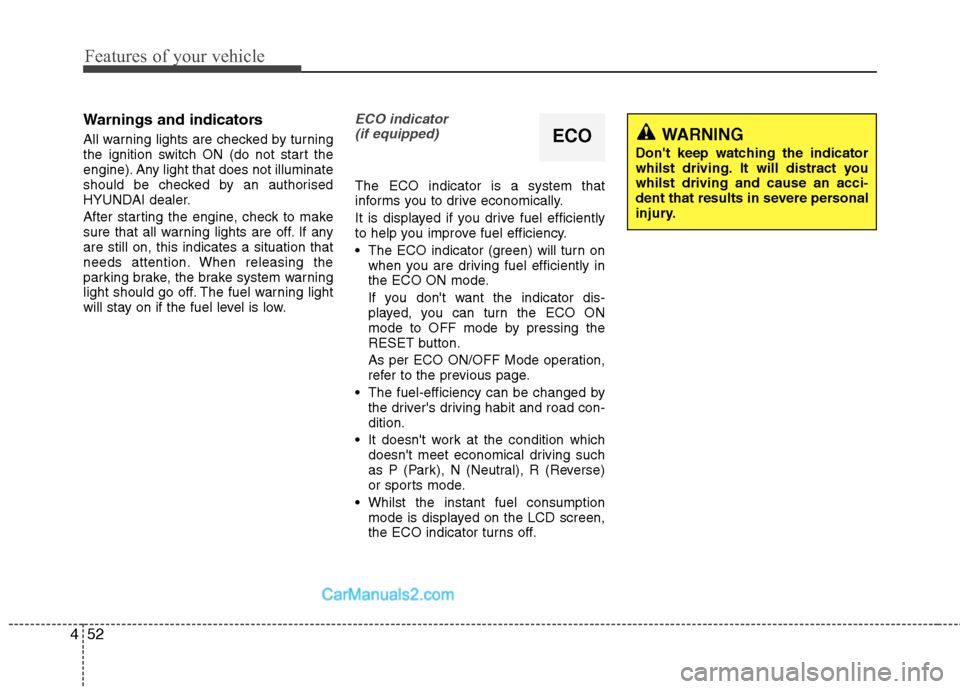
Features of your vehicle
52
4
Warnings and indicators
All warning lights are checked by turning
the ignition switch ON (do not start the
engine). Any light that does not illuminate
should be checked by an authorised
HYUNDAI dealer.
After starting the engine, check to make
sure that all warning lights are off. If anyare still on, this indicates a situation that
needs attention. When releasing the
parking brake, the brake system warning
light should go off. The fuel warning light
will stay on if the fuel level is low.ECO indicator
(if equipped)
The ECO indicator is a system that
informs you to drive economically.
It is displayed if you drive fuel efficiently
to help you improve fuel efficiency.
The ECO indicator (green) will turn on when you are driving fuel efficiently in
the ECO ON mode.
If you don't want the indicator dis-
played, you can turn the ECO ON
mode to OFF mode by pressing the
RESET button.
As per ECO ON/OFF Mode operation,
refer to the previous page.
The fuel-efficiency can be changed by the driver's driving habit and road con-dition.
It doesn't work at the condition which doesn't meet economical driving such
as P (Park), N (Neutral), R (Reverse)
or sports mode.
Whilst the instant fuel consumption mode is displayed on the LCD screen,
the ECO indicator turns off.
ECOWARNING
Don't keep watching the indicator
whilst driving. It will distract youwhilst driving and cause an acci-
dent that results in severe personal
injury.
Page 127 of 363
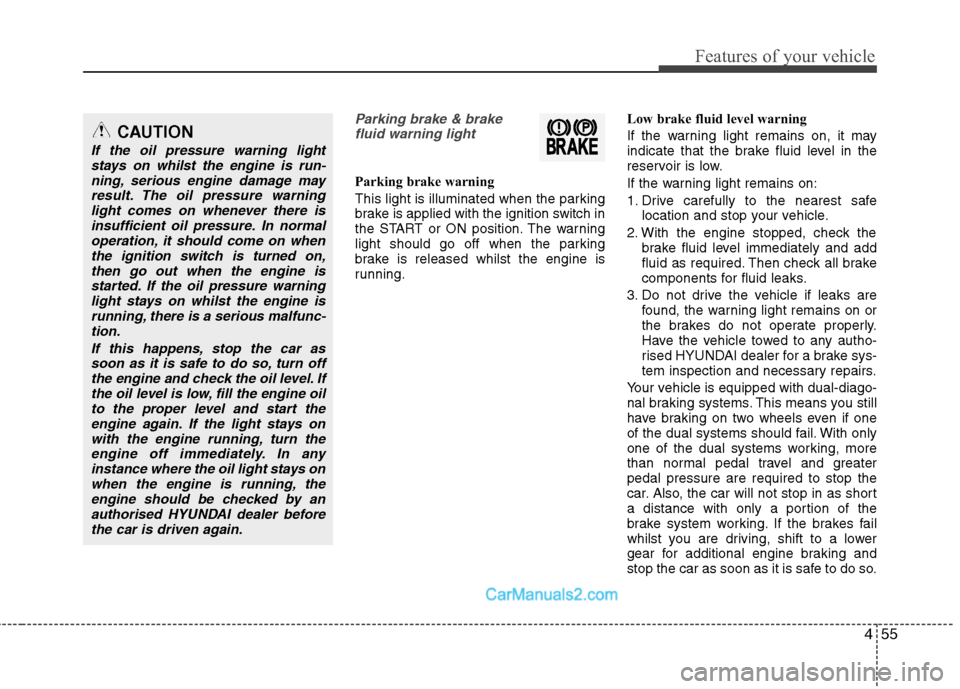
455
Features of your vehicle
Parking brake & brakefluid warning light
Parking brake warning
This light is illuminated when the parking
brake is applied with the ignition switch in
the START or ON position. The warning
light should go off when the parking
brake is released whilst the engine is
running. Low brake fluid level warning
If the warning light remains on, it may
indicate that the brake fluid level in the
reservoir is low.
If the warning light remains on:
1. Drive carefully to the nearest safe
location and stop your vehicle.
2. With the engine stopped, check the brake fluid level immediately and add
fluid as required. Then check all brake
components for fluid leaks.
3. Do not drive the vehicle if leaks are found, the warning light remains on or
the brakes do not operate properly.
Have the vehicle towed to any autho-
rised HYUNDAI dealer for a brake sys-
tem inspection and necessary repairs.
Your vehicle is equipped with dual-diago-
nal braking systems. This means you still
have braking on two wheels even if one
of the dual systems should fail. With only
one of the dual systems working, more
than normal pedal travel and greaterpedal pressure are required to stop the
car. Also, the car will not stop in as short
a distance with only a portion of the
brake system working. If the brakes fail
whilst you are driving, shift to a lower
gear for additional engine braking and
stop the car as soon as it is safe to do so.
CAUTION
If the oil pressure warning light stays on whilst the engine is run-
ning, serious engine damage mayresult. The oil pressure warninglight comes on whenever there is insufficient oil pressure. In normal
operation, it should come on whenthe ignition switch is turned on,then go out when the engine is
started. If the oil pressure warninglight stays on whilst the engine isrunning, there is a serious malfunc-tion.
If this happens, stop the car assoon as it is safe to do so, turn off the engine and check the oil level. Ifthe oil level is low, fill the engine oilto the proper level and start the
engine again. If the light stays onwith the engine running, turn theengine off immediately. In any instance where the oil light stays on
when the engine is running, theengine should be checked by an authorised HYUNDAI dealer beforethe car is driven again.